The Live Online Classrooms at Harvard Business School provide an immersive and dynamic classroom experience in which case method teaching and learning comes to life in a state-of-the-art virtual environment.
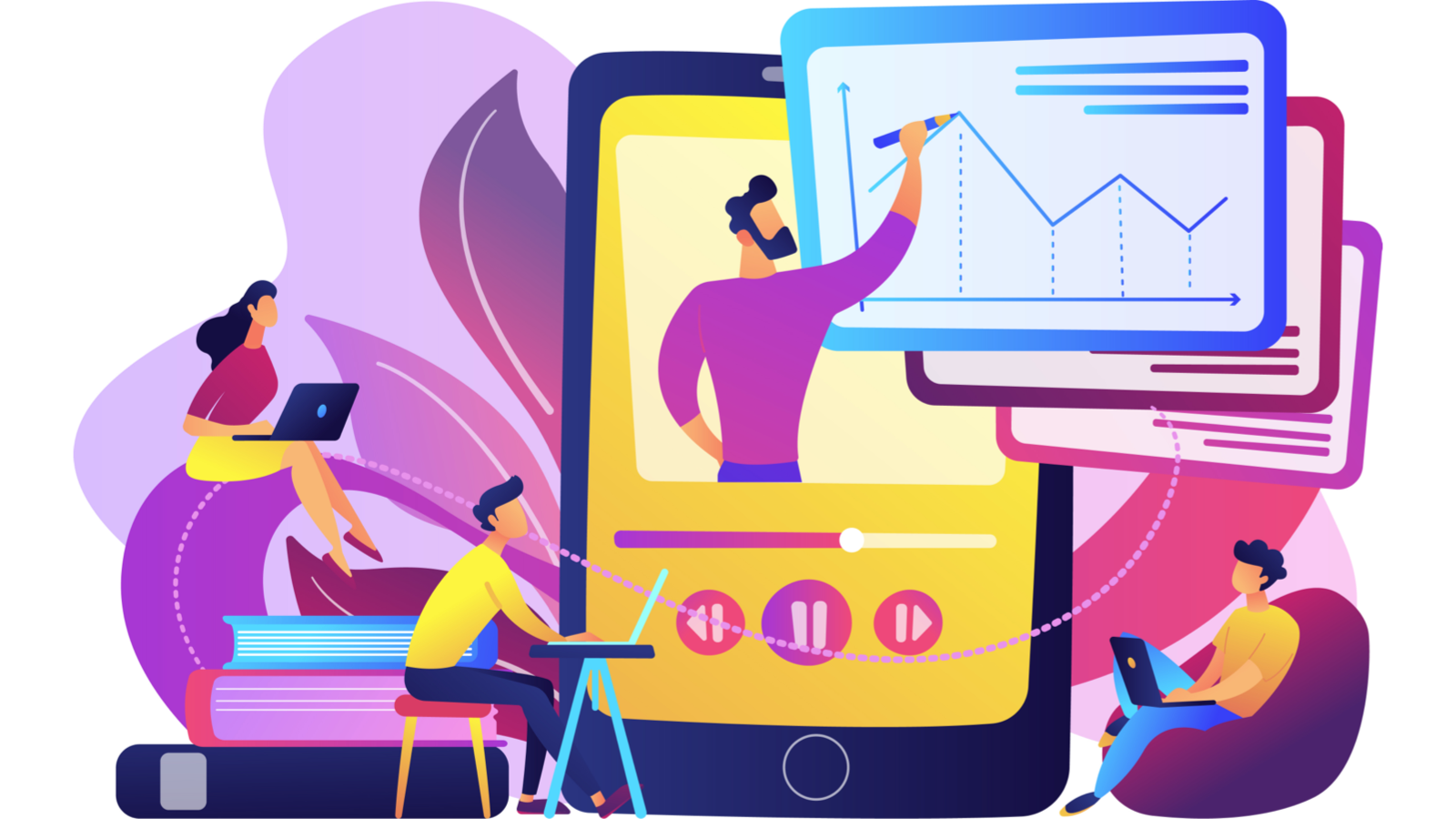
Institutional Profile
Founded in 1908 as part of Harvard University, Harvard Business School (HBS) is located on a 40-acre campus in Boston. With more than 250 faculty members, HBS offers full-time programs leading to MBA and PhD degrees, as well as more than 175 Executive Education programs. For more than a century, HBS faculty have drawn on their research, their experience working with organizations worldwide, and their passion for teaching to educate leaders who make a difference in the world. HBS and its curriculum attract bold thinkers and collaborative learners who will shape the practice of business and entrepreneurship around the globe.
The Challenge/Opportunity
With growing interest in opportunities for virtual teaching and learning, HBS leaders set out to design a space that would allow faculty to teach a class of remote learners in a way that replicates—for the instructor and the students—the look and feel of a conventional HBS classroom. HBS Live Online Classrooms (LOCs) help scale the reach of the school's research and pedagogy, enabling remote learners and participants to benefit from—and fully contribute to—case discussions from anywhere in the world (see figure 1).
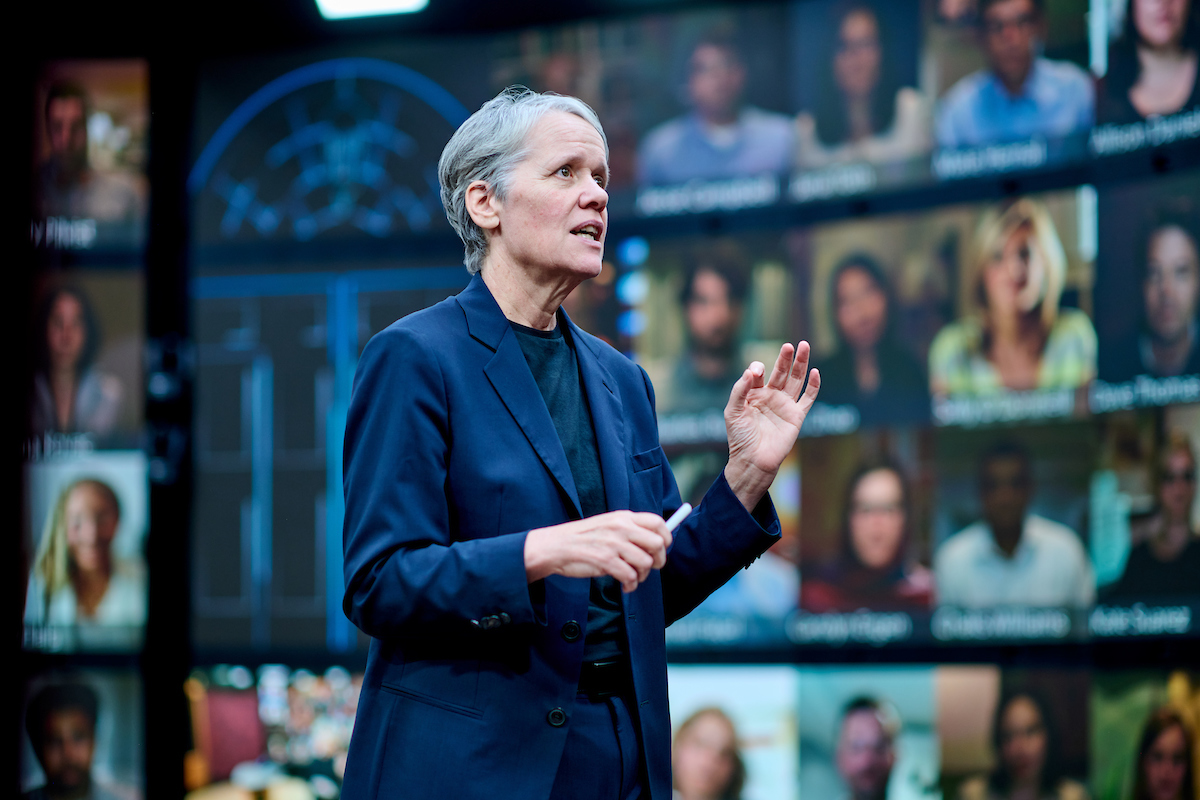
The case method centers around a classroom conversation led by student participants, as opposed to a one-way lecture by faculty. Participants prepare for a class by reading case studies about real people facing real business challenges. They come to class ready to share their ideas and experiences with their classmates, and professors facilitate the discussion by calling on participants to debate how they would respond to the situation and why. The case method requires quick and seamless communication between faculty and participants, following the natural flow of conversation.
To replicate this experience and support the flow of a case discussion in a virtual environment, HBS needed to implement technology and a production approach that are, to our knowledge, fundamentally different from anything previously attempted in any setting. Faculty members and participants needed to be able to communicate as though they were in the same physical space, and the technology had to fade away so that everyone could focus on the discussion. After multiple rounds of ideation and testing, HBS created a virtual environment that leveraged a custom LED-display wall, directional sound, and a live-television production approach, creating a space that, for faculty and participants, felt like a traditional classroom.
The Process
The Teaching Experience
One of the primary goals for the LOCs is to replicate the case method in a virtual space, allowing for fluid two-way conversation, debate, and full engagement—not just one-way projection. While reducing audio latency was a critical component, equally important was designing the space that gave instructors full access to the inputs and tools they use to manage a conversation, such as being able to see participant reactions and ensuring that their body language translated to participants in the same way as it would in a physical classroom.
Instead of standing in front of chairs, the instructor faces a 10-foot-tall by 50-foot-wide curved LED wall (see figure 2). It features life-size video feeds for up to 96 remote participants, as well as individual speakers and cameras for each person. Having high-definition LED screens and directional sound for each participant facilitates classroom discussion better than other virtual meeting programs. When a participant speaks, faculty know exactly where to turn without needing to look for a visual cue such as a flashing border on a screen. Every participant has a larger-than-life-size image, so faculty can read micro facial expressions and other nonverbal communication signals. This helps faculty get a feel for how the participants are responding in the moment, such as whether they're leaning into the discussion or appear to be disengaged.
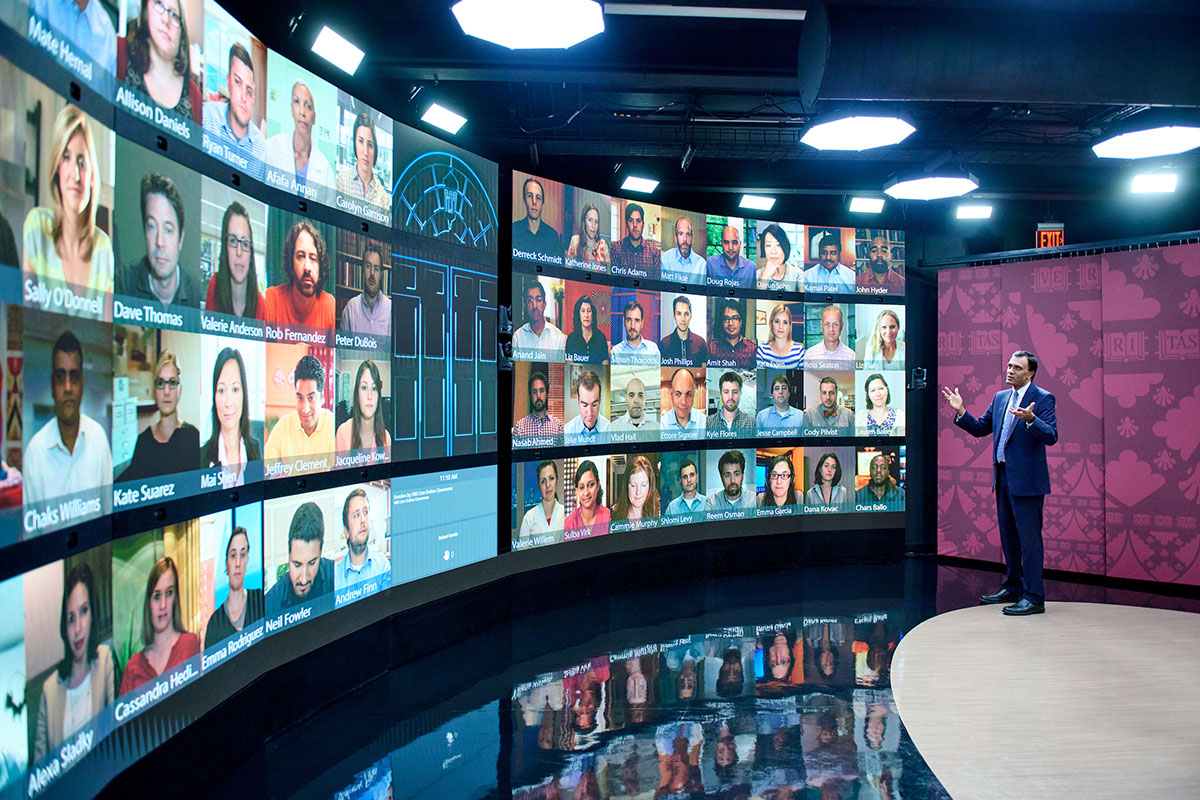
During the design phase, multiple cardboard prototypes were set up to gather faculty feedback on the dimensions and configuration. The first prototype used especially large participant screens, which required curving the wall much further around the sides of the space, but that model was quickly discarded when faculty reported that wrapping the LED wall so far around the sides made it feel like they would miss participants on the edges. A second prototype better balanced participant screen size and locations. The addition of digital "aisles" divided the LED wall into three equal sections, like our physical classrooms, which helped faculty better remember which side of the room participants are seated on.
The rest of the physical space was designed to replicate HBS tiered, horseshoe-shaped classrooms. Each LOC features a roughly 500-square-foot teaching area, similar in size and design to the teaching area in a classroom on campus. Unlike other forms of virtual teaching, faculty aren't limited to standing in a fixed location. In fact, faculty are encouraged to move around the room and use the full space. Each session is treated as a live, broadcast event—behind the scenes, a world-class production team controls 10 pan-tilt-zoom cameras in the classroom and choreographs every angle in real time and adjusts the cameras to follow the faculty at their own pace.
Compared with teaching in front of a webcam on a laptop, this configuration infuses each class with the same energy as a classroom. When a faculty member gestures to make a point or moves from the front of the room to the electronic boards to write a student's comment, the control room zooms in to emphasize their body language. If a faculty member wants to connect with an individual student, a shot from the side or back of the room shows them approaching that student's section of the wall and closing the physical distance, just like in a conventional classroom. The approach is so effective that when a faculty member pressed a student in California on their opinion on an issue, they backed away from their webcam as they saw the faculty member approaching their screen, despite being 3,000 miles away.
"Stepping into the HBS Live Online Classroom is like stepping into a futuristic [HBS campus] classroom, backed by a team of engineers and coordinators who seamlessly and unobtrusively bring the classroom experience to life for participants and ensure smooth sailing for the professor," said Joshua Margolis, James Dinan and Elizabeth Miller Professor of Business Administration; Unit Head for the Organizational Behavior unit. "You can focus fully on engaging the participants in a case discussion as you would in any on-campus classroom, but with participants joining from around the world."
The LOCs are equipped to accommodate faculty who prefer to teach with a range of physical and virtual materials. Faculty can plug in their own devices—laptops, tablets, or phones—into the desk, and a Microsoft Surface tablet is available for them to use with the room as well (see figure 3). If faculty have a PowerPoint presentation, the control room staff can pull up the slides and mix them into the session. The control room team can also access other materials the faculty member might want to share, from videos to Microsoft Excel spreadsheets. A document camera, installed in the ceiling, also integrates into the platform.
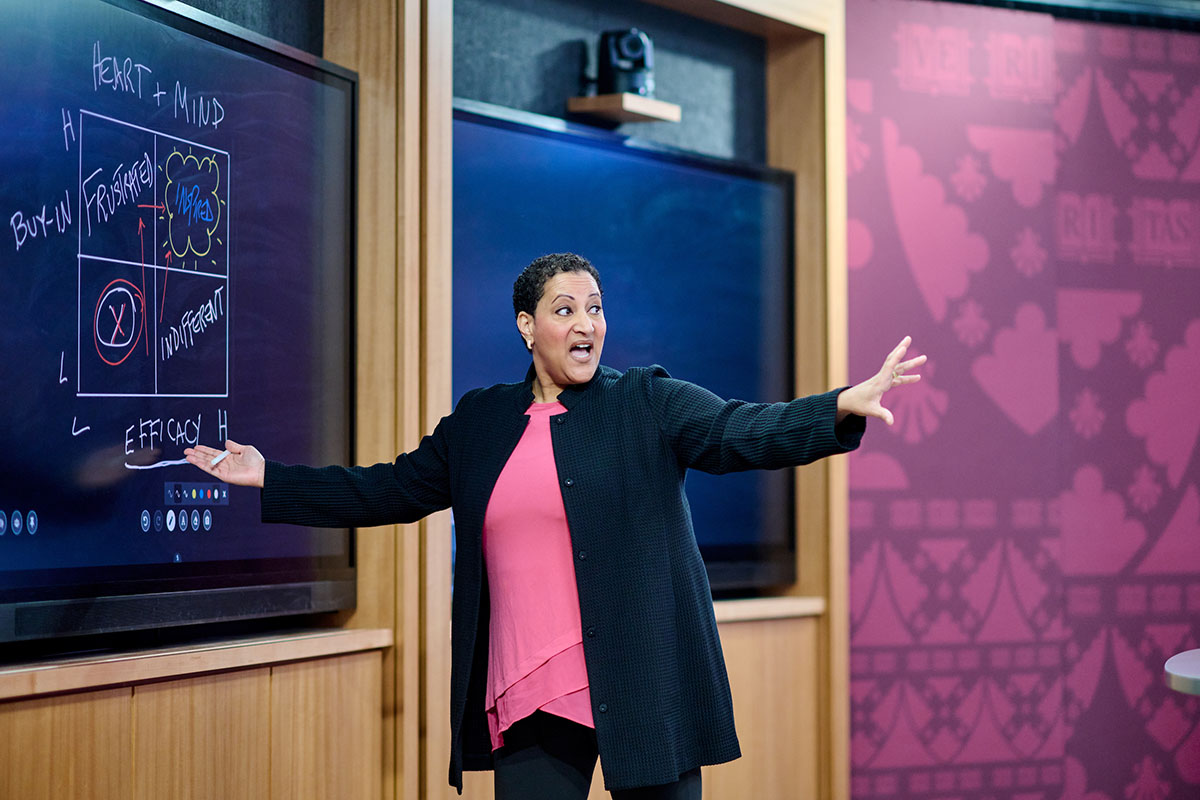
Similar to the design of a physical classroom, each LOC features three touchscreen blackboards, each with three tabs, allowing for nine surfaces. Faculty can use four colors of virtual chalk, shading, an eraser, and an undo button. Before class, they can preload and conceal content on these boards, revealing it at key moments for impactful class discussions. The selection of a stylus for these touchscreen blackboards involved extensive user testing, as the original pens were unsatisfactory. After multiple trials, a staff member created a custom stylus in his home workshop to resemble a piece of chalk in look, feel, and sound, enhancing the immersive experience. Some faculty members are so engaged that they instinctively try to wipe their hands after using the electronic chalkboards.
"The technology is extraordinary—unlike anything I've experienced in other remote settings," said Youngme Moon, Donald K. David Professor of Business Administration at HBS. "And the attention to detail the HBS Live Online Classrooms team brings to each session elevates the experience even further. It's been a game-changer for us."
The Learning Experience
For students, participating at home on a laptop while hundreds or thousands of miles away from the HBS campus, the primary goal was to make sure the technology could fade away so that they could focus all their energy on the case discussion. If a student is cold-called by a faculty member in the middle of an intense discussion, they need to be able to respond immediately instead of searching through a complicated interface for the right view and button.
With a control room team pulled from local broadcast professionals, LOC staff work with faculty to create a curated experience for participants that meets the needs of the HBS case method (see figure 4). Support staff manually select camera angles and layouts to highlight the faculty member and any additional visuals. This broadcast approach provides equal access for participants to see and hear classroom discussion. For participants, there's no bad seat on the wall—regardless of their place in the classroom, every student sees the same close-up emphasizing the faculty member's excitement over a twist in the discussion or perfectly framed shot as they scribble furiously on the boards. Simultaneously, the control room team mixes in the relevant feeds of the teaching materials or views of the touchscreen blackboards so that everyone can effortlessly follow along. This prevents participants from being distracted by navigating the interface, freeing them up to concentrate on the discussion.
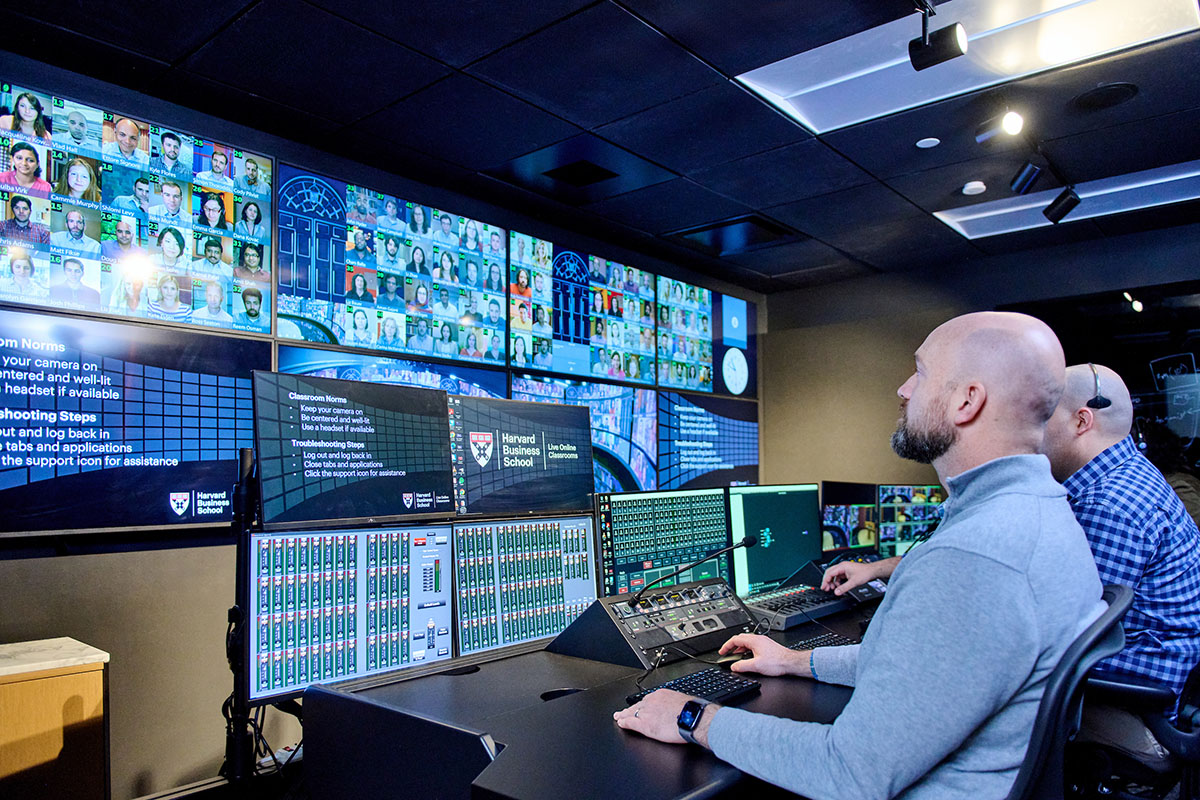
When a student is called on to speak, more production magic happens. The control room brings the webcam of that person into the production mix just like one of the cameras in the main classroom, and that student appears side-by-side with the faculty member on everyone's screens. This ensures that other classmates can quickly and clearly identify them, and it also recreates the experience of watching a conversation between two people in a physical classroom. Once again, the student called on to speak and their classmates don't need to do anything other than engage in the conversation.
Unlike other video conferencing tools that may pull the focus of the video to someone who coughs or has background noise, the LOC experience is a more conscious approach to virtual education that keeps participants focused on teaching and learning. Program delivery staff continually review post-program feedback from participants to better anticipate the needs of the users and keep up with the demand. When initial feedback indicated that some participants wanted to see more reactions from their classmates, the production team revamped its approach to incorporate panning shots of the video wall and wider shots that also captured participants in the background as the faculty moved throughout the space. These changes helped strengthen the sense that everyone was in the room together.
"You actually have an opportunity to observe more people at a time, so you really, really have a full, immersive experience," said Yulia Chekunaeva, director of Capital Markets & Strategic Initiatives, UK En + Group, a participant in an HBS Executive Education program.
The LOC is user friendly, requiring no specialized software to access it and offering compatibility with Google Chrome and Microsoft Edge. Participants have a virtual raised-hand option, which appears as a large icon over the face of the participant on screen for five seconds before the icon becomes small for 55 seconds, then fades away. This feature replicates a classroom environment, where physical limitations determine how long someone can keep their hand up. As faculty members call on participants and other raised-hand icons eventually fade away, the case method discussion keeps moving forward as it would in an in-person setting. A raised-hand counter is available (for quick room polls), as are virtual tools for participants to draw together on a digital blackboard screen and gauge class reactions.
As they would in a traditional classroom, participants can split into breakout rooms, which are created and maintained by the control room. Faculty still see video from the participants while they are in breakout rooms, which means that they can monitor engagement in real time and jump in to individual groups to address questions or facilitate as needed. The enhanced interactive capabilities eliminate the need for participants to navigate away or wait until they are brought back into the main virtual room to ask a question.
The LOC makes it easy for notes and charts to be shared with everyone. After the class, learning materials—including the content from the touchscreen blackboards—can be exported as PDFs and shared with the faculty and participants for easy reference later. Class sessions can be recorded and shared with participants. The ability to so closely mimic an in-person teaching and learning, combined with high-tech and innovative tools, is what staff call a "classroom plus" experience.
"I never expected that the virtual experience would come so close to in-person," said Abhishek Gupta, project executive, U.S.A. Turner Construction Company, a participant in an HBS Executive Education program. "I almost miss nothing in the virtual experience."
Outcomes and Lessons Learned
When the COVID-19 pandemic lockdowns started in March 2020, the LOCs were already in re-development on campus based on a previous version that had operated out of a local television production facility. The team was asked to accelerate development and opened in June 2020, several months earlier than expected, to support moving the Comprehensive Leadership Programs online during the pandemic. In the first year of operation, they supported 875 classes, more than four times the volume projected pre-pandemic.
From the launch of two LOC spaces on the HBS campus in June 2020 through December 2023, more than 1,848 sessions were held for 132 unique faculty and 12,731 unique participants. In FY23 alone (July 1, 2022–June 30, 2023), nearly 400 sessions were held in the classrooms for 60 different faculty members and more than 3,200 participants. The classrooms have seen steady growth in recent years, as well as the development of new partnerships with departments and initiatives across campus to support more aspects of the school's mission.
As the coronavirus pandemic has waned, the LOCs continue to be a useful resource for education and innovation at HBS. Aligning their size with our physical classrooms means that new hybrid programs can move seamlessly between the physical and virtual spaces. Participants in the Executive Education program have praised the LOCs for providing more opportunities for virtual learning and enabling more balance in their work and personal lives. Creating a virtual learning space that mimics an on-campus experience shortens the time executives need to be away from their work and home lives, which helps increase gender diversity in academic programs.
The impact of the LOCs has gone beyond case method discussions. Because these classrooms are one of the most engaging spaces available at HBS, faculty and students continue to experiment with new ways to use the platform. Three recent examples highlight the diversity of these efforts.
- Recording a Podcast: The combination of technology and talented staff that makes the LOCs an innovative teaching and learning space also creates a unique platform for creating engaging media and connecting with individuals globally. Brian Kenny, chief marketing and communications officer at HBS, hosts Cold Call, which distills case studies into podcast form. Kenny used the LOC to bring his listeners into an episode, giving them a front-row seat in the virtual classroom for a conversation with Raffaella Sadun, Charles Edward Wilson Professor of Business Administration; Senior Associate Dean for HBS Publishing, and Benedetto Vigna, CEO of Ferrari, about whom Sadun had written a business case. As the three discussed how the luxury automaker used sustainability as a catalyst for innovation, long-time listeners were able to participate in the conversation by asking questions, enhancing the traditional podcast experience by creating a direct connection with the audience. (Listen to the full podcast, "Can Sustainability Drive Innovation at Ferrari?")
- Practicing Public Speaking: In the course "The Arts of Communication," Candace Bertotti, Adjunct Lecturer in Public Policy, prepares MBA students for the future of communication. As virtual technologies become more commonplace, it is critical to make sure leaders understand the preparation that goes into those formats, as well as the skills and presence required to use them effectively. As part of the course, students had opportunities to practice in the LOC, culminating in the live delivery of a TED-style talk to their peers via the classrooms. Students overwhelmingly praised the opportunity, noting that it helped prepare them for the situations that they would be in as leaders in the future.
- Performing a Piano Concert: Madeline Meehan, Director of Campus Activation, is responsible for building community between faculty, staff, students, and alumni. As Meehan sought to bring people together across geographic boundaries, she approached the LOC team to discuss a student concert in front of a live virtual audience that could also be broadcast via livestream to individuals across the world. Pianist Lisa Qiya Li '23, accompanied by cellist Maddie Tucker '23, weaved together performances with conversation on the role of classical music in her life, leveraging the unique features of the space to interact with the audience throughout the session. Meehan was thrilled with the event, impressed that the technology faded away and it "really felt like everybody was in the room."
The HBS Live Online Classrooms have effectively integrated technology with traditional teaching methods, offering an immersive and dynamic virtual learning experience. By merging state-of-the-art audiovisual hardware with the proven pedagogy of case method teaching, these spaces have not only upheld but also enhanced the educational experience. This initiative expands the reach of HBS's teaching and reflects an adaptive approach to the evolving landscape of business education, making HBS more available to our global audience without compromising the quality of interaction and engagement.
Jeanne Po is Managing Director, Learning Experience Design & Interactive Spaces, at Harvard Business School.
Dustin Hilt is Director, HBS Live Online Classrooms, at Harvard Business School.
Annie Harrison is Communications Lead, HBS IT, at Harvard Business School.
© 2024 Jeanne Po, Dustin Hilt, and Annie Harrison.
